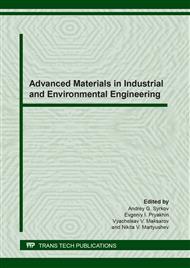[1]
V. G. Pustovalov, A. G. Matveenko, A. S. Seminozhenkov, Checking perpendicularity between slideways and tables for metal-working machines, Measurement Techniques (1988).
DOI: 10.1007/bf00865086
Google Scholar
[2]
O. I. Kazanin, A. A. Sidorenko, A. A. Meshkov, Organizational and technological principles of realization of the modern high productive longwall equipment capacity, Coal 12 (2019) 4-3.
DOI: 10.18796/0041-5790-2019-12-4-13
Google Scholar
[3]
Y. Yamane, M. Fukuta, N. Narutaki, High speed finishing for guide ways of machine tools, Journal of the Japan Society for Precision Engineering (1999).
Google Scholar
[4]
V. D. Vinokurov, Technology of gray iron additive treatments, Soviet castings technology (1989).
Google Scholar
[5]
Yu. G. Kotlov, V. I. Lozovaya, V. F. Siroklin, Investigation of the crevice corrosion of cast iron in inhibited antifreezes by the polarization resistance method, Protection of Metals (1989).
Google Scholar
[6]
A.P. Gusenkov, I.M. Petrova, M.Ya. Gal'perin, K. Jokipi, M.A. Alimov, Determination of probabilistic fatigue diagrams as applied to high strength cast iron parts, Issues of Machines Strength and Durability (1992).
Google Scholar
[7]
V. F. Bevza, V. P. Grusha, V. A. Krasnyi, Use of Directional Solidification for Improving Tubular Workpiece Quality of Different Cast Irons, Metallurgist 62(5-6) (2018) 521-531.
DOI: 10.1007/s11015-018-0689-8
Google Scholar
[8]
V.V. Kalmykov, M.V. Mousokhranov, E.V. Logutenkova, Dependence of physical and mechanical properties of metal surfaces on microgeometric parameters, IOP Conference Series: Materials Science and Engineering 483(1) (2019) 012045.
DOI: 10.1088/1757-899x/483/1/012045
Google Scholar
[9]
B. Denkena, T. Grove, E. Hasselberg, Workpiece shape deviations in face milling of hybrid structures, Materials Science Forum 825-826 (2015) 336-343.
DOI: 10.4028/www.scientific.net/msf.825-826.336
Google Scholar
[10]
D. Y. Ershov, E. G. Zlotnikov, D. Y. Timofeev, Analysis of proper fluctuations of technological systems, IOP Conference Series: Materials Science and Engineering 560(1) (2019) 012015.
DOI: 10.1088/1757-899x/560/1/012015
Google Scholar
[11]
V. I. Bolobov, S. A. Chupin, V. S. Bochkov, I. I. Mishin, Service life extension for rock cutters by increasing wear resistance of holders by thermomechanical treatment, Mining Journal 5 (2019) 67-71.
DOI: 10.17580/gzh.2019.05.13
Google Scholar
[12]
V. V. Maksarov, A. E. Efimov, Simulation modeling of dynamic characteristics of machining in NI LabView software environment to improve processing technique of a rod component, IOP Conference Series: Earth and Environmental Science 194(2) (2018) 022021.
DOI: 10.1088/1755-1315/194/2/022021
Google Scholar
[13]
Y. Liu, T. Li, Y. Zhang, L. Dai, C. Lü, Study on modeling of milling processing system and parameter identification algorithm, Journal of Vibration, Measurement and Diagnosis 34(5) (2014) 868–872.
Google Scholar
[14]
A.E. Efimov, V.V. Maksarov, D.Y. Timofeev, Modeling dynamic processes at stage of formation of parts previously subjected to high-energy laser effects, IOP Conference Series: Materials Science and Engineering 327(2) (2018) 022026.
DOI: 10.1088/1757-899x/327/2/022026
Google Scholar
[15]
V. Maksarov, V. Krasnyy, The formation of surface roughness of piston rings for the purpose of improving the adhesion of wear-resistant coatings, Key Engineering Materials 736 (2017) 73-78.
DOI: 10.4028/www.scientific.net/kem.736.73
Google Scholar
[16]
J. Olt, V.V. Maksarov, Cutting process simulation on the basis of rheological properties of metals, in: Annals of DAAAM and Proceedings of the International DAAAM Symposium, January 2015, pp.229-237.
DOI: 10.2507/26th.daaam.proceedings.032
Google Scholar
[17]
V.V. Maksarov, A. I. Keksin, Technology of magnetic-abrasive finishing of geometrically-complex products, IOP Conference Series: Materials Science and Engineering 327 (2018) 042068.
DOI: 10.1088/1757-899x/327/4/042068
Google Scholar
[18]
V.V. Maksarov, A.I. Keksin, I.A. Filipenko, Improvement of magnetic-abrasive finishing of nonuniform products made of high-speed steel in digital conditions, Key Engineering Materials 836 (2020) 71-78.
DOI: 10.4028/www.scientific.net/kem.836.71
Google Scholar
[19]
V. N. Andreev, E. V. Sedov, Milling grey iron with ceramic-tipped face mills, Soviet Engineering Research 1(5) (1981) 87-88.
Google Scholar
[20]
S. Ben Salem, Tool-life model for ceramics through experimental design in high speed machining (HSM) of 36NiCrMo16 steel, International Review of Mechanical Engineering 7(3) (2015) 499-506.
Google Scholar
[21]
A.R. Mavliutov, E.G. Zlotnikov, Optimization of cutting parameters for machining time in turning process, IOP Conference Series: Materials Science and Engineering 327(4) (2018) 042069.
DOI: 10.1088/1757-899x/327/4/042069
Google Scholar
[22]
A.D. Khalimonenko, R.V. V'yushin, Accuracy of the machining turning process of the workpieces when cutting tool equipped with removable ceramic inserts, Journal of Mining Institute 209 (2014) 99-103.
Google Scholar
[23]
V. Maksarov, A. Khalimonenko, D. Timofeev, Machining quality when lathing blanks with ceramic cutting tools, Agronomy Research 12(1) (2014) 269-278.
Google Scholar
[24]
V. Maksarov, A. Khalimonenko, J. Olt, Effect of porosity on the performance of cutting ceramics, Agronomy Research 14 (2016) 1043-1052.
Google Scholar
[25]
V. Maksarov, A. Khalimonenko, Forecasting performance of ceramic cutting tool, Key Engineering Materials 736 (2017) 86-90.
DOI: 10.4028/www.scientific.net/kem.736.86
Google Scholar
[26]
V. V. Maksarov, A. D. Khalimonenko, K. G. Matrenichev, Stability analysis of multipoint tool equipped with metal cutting ceramics, IOP Conference Series: Earth and Environmental Science 87(8) (2017) 082030.
DOI: 10.1088/1755-1315/87/8/082030
Google Scholar
[27]
V. V. Maksarov, A. D. Khalimonenko, Quality assurance during milling of precision elements of machines components with ceramic cutting tools, International Review of Mechanical Engineering 12(5) (2017) 437-441.
DOI: 10.15866/ireme.v12i5.14570
Google Scholar


